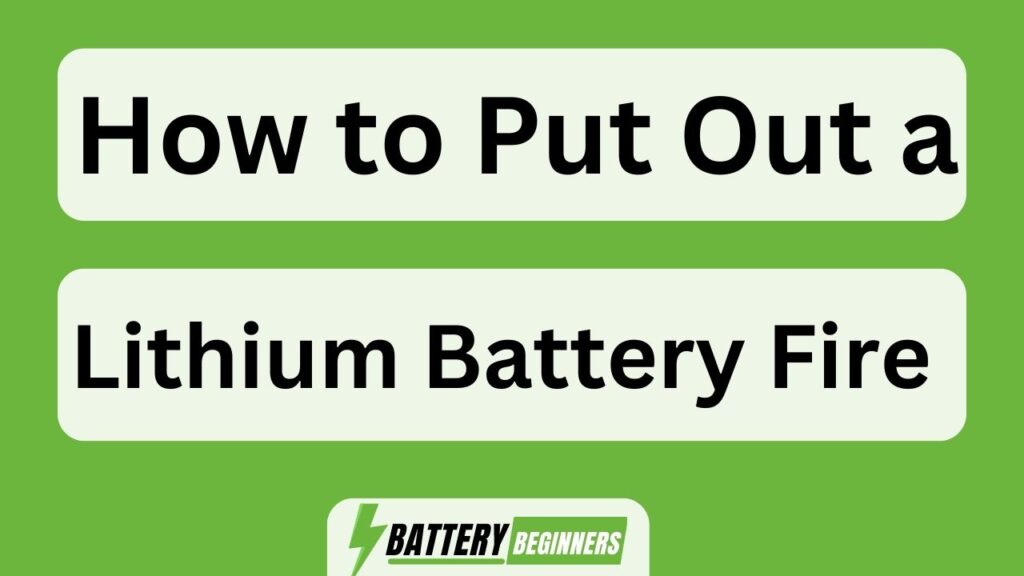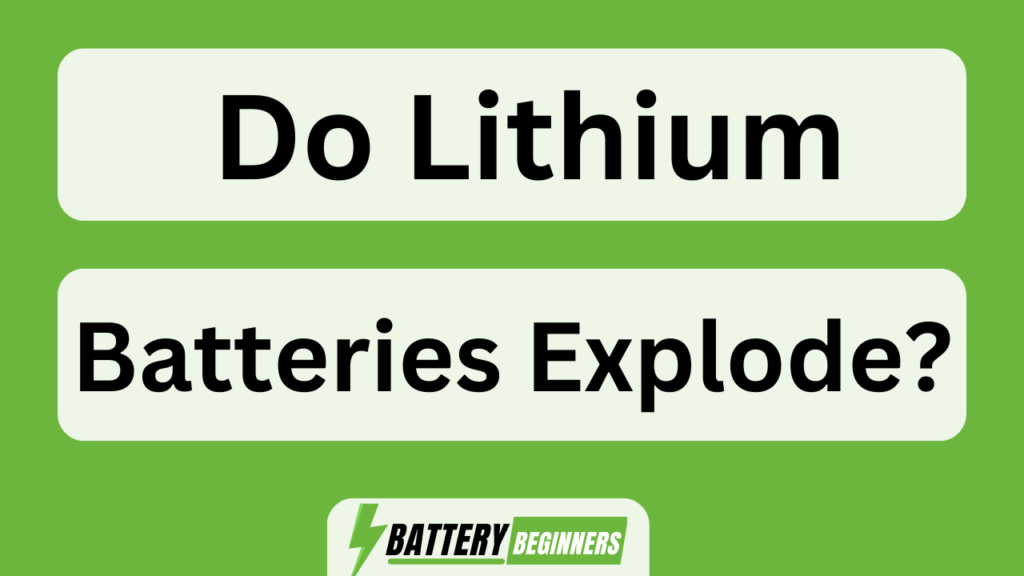In the realm of electrical devices, lithium batteries have become increasingly popular due to their high energy density.
However, this surge in usage has also raised concerns about the potential for lithium battery fires.
These fires can be highly dangerous and require immediate action.
This article provides a comprehensive guide on how to effectively extinguish a lithium battery fire, emphasizing safety measures and proper disposal techniques.
By following these expert recommendations, individuals can minimize risks and respond efficiently in case of such emergencies.
Key Takeaways How To Put Out A Lithium Battery Fire
- Signs of re-ignition include high fire temperature, presence of smoke or fumes, no decrease in heat at the fire site, and the fire not extinguishing unexpectedly.
- Monitoring for residual smoke or fumes is important as even small amounts indicate hidden fires, and immediate action should be taken to address them promptly.
- Extinguishing techniques for lithium battery fires involve using Class D fire extinguishers with specialized dry-powder compound and submerging batteries in the compound.
- Proper disposal methods should be promptly implemented after a fire incident, ensuring the safe disposal of lithium batteries and minimizing environmental impact.
Understand the Dangers of Lithium Battery Fires
The dangers of lithium battery fires should be comprehended in order to effectively address the issue. Understanding the risks associated with these fires is crucial for implementing appropriate safety precautions.
Lithium batteries are widely used in various electronic devices due to their high energy density, but they can pose serious hazards if mishandled or damaged. When a lithium battery catches fire, it releases toxic gases and can produce intense heat, leading to explosions and the spread of flames.
As such, it is essential to take necessary safety precautions while dealing with these fires, such as wearing protective clothing and using appropriate firefighting equipment. Additionally, understanding how these fires behave and assessing the situation accurately will enable individuals to ensure personal safety and respond effectively.
Assess the Situation and Ensure Personal Safety
First, evaluate the surrounding environment and prioritize personal safety measures when confronting a fire involving a lithium battery. Assessing risks is crucial to determine the appropriate course of action. It is important to remember that lithium battery fires can release toxic fumes and emit intense heat, which can lead to explosions or the spread of flames. Therefore, it is essential to wear proper personal protective equipment (PPE) such as gloves, goggles, and fire-resistant clothing. Additionally, ensure that there are no flammable materials in close proximity to the fire. Evacuating the area and alerting others nearby should also be considered if the situation escalates. By assessing risks and taking necessary precautions for personal protection, one can effectively address a lithium battery fire while minimizing potential harm or injuries.
Transition: Once personal safety has been ensured, it is imperative to promptly call for emergency assistance to handle the situation further.
Call for Emergency Assistance
Promptly summoning emergency assistance is crucial when faced with a fire involving a lithium battery. Calling for help ensures that trained professionals with the necessary equipment and expertise are promptly dispatched to the scene.
When making the call, it is important to provide accurate information about the location of the incident, including any potential hazards or obstacles that might hinder emergency responders. Additionally, it is essential to follow any instructions given by the emergency operator in order to minimize risks and maximize efficiency.
By contacting emergency services, individuals can rely on their timely response to mitigate the fire’s impact and prevent its escalation. This immediate action sets the stage for subsequent steps like removing flammable materials from the area without delay.
Remove Flammable Materials from the Area
To minimize the risk of further escalation, it is imperative to remove any flammable materials from the area affected by the fire involving a lithium battery. Fire prevention and safety measures are crucial in handling such incidents.
Flammable materials, including liquids, gases, or even combustible objects nearby, can exacerbate the fire and increase its intensity. Therefore, promptly identifying and eliminating these materials is essential to prevent the spread of flames and potential explosions. This step ensures that the fire remains contained within a limited area and reduces the likelihood of injuries or property damage.
Once all flammable materials have been removed, it becomes safer to proceed with using a class D fire extinguisher or sand to smother the fire without causing further harm or complications.
Use a Class D Fire Extinguisher or Sand to Smother the Fire
One effective method to control the fire involving a lithium battery is by utilizing a Class D fire extinguisher or sand to smother the flames. A Class D fire extinguisher is specifically designed for fires involving combustible metals, such as lithium. It contains a dry powder that chemically reacts with the metal and forms a crust over it, preventing further combustion. Sand can also be used as an alternative if a Class D fire extinguisher is not available. When applied to the burning lithium battery, sand absorbs heat and suffocates the fire by cutting off its oxygen supply.
It is important to note that water or foam should never be used on a lithium battery fire as they may react with the chemicals inside the battery, exacerbating the situation.
Moving on to the subsequent section about ‘do not use water or foam on a lithium battery fire’…
Do NOT Use Water or Foam on a Lithium Battery Fire
Using water or foam to extinguish a fire involving a lithium battery is strongly discouraged due to the potential chemical reactions that may worsen the situation. Lithium batteries are highly reactive and can react violently with water, releasing flammable hydrogen gas and intensifying the fire. Foam, on the other hand, may not effectively cool down the battery and prevent re-ignition. To highlight the importance of avoiding water or foam in such situations, a table can be used:
| Fire Suppression Method | Effectiveness |
|---|---|
| Class D Fire Extinguisher | Highly effective |
| Sand | Effective |
| Water | Not recommended |
| Foam | Not recommended |
It is crucial to prioritize safety when dealing with lithium battery fires. Instead of using ineffective methods, individuals should focus on utilizing appropriate fire suppression techniques like class D fire extinguishers or sand. If possible, disconnecting the battery or removing the power source should also be considered as an additional precautionary measure before attempting any further steps.
If Possible, Disconnect the Battery or Remove the Power Source
When faced with a lithium battery fire, it is crucial to take immediate action.
Continuing from the previous subtopic, ‘Do NOT Use Water or Foam on a Lithium Battery Fire,’ it is important to remember that water and foam can exacerbate the situation by spreading the fire and releasing toxic gases.
Instead, if possible, one should promptly disconnect the battery or remove its power source. By doing so, the electrical circuit will be interrupted, preventing further supply of energy to the fire and minimizing its potential for spreading. This step is vital in containing the fire and reducing its intensity.
To visualize this process, imagine a series of interconnected wires providing power to the battery like veins supplying blood to an organ. Disconnecting these wires effectively cuts off the fuel supply feeding into the flames.
Following this critical measure, evacuation of the area must be initiated immediately while alerting others about the ongoing emergency situation without delay.
Evacuate the Area and Alert Others
Evacuation of the area and alerting others about the ongoing emergency situation should be initiated immediately, ensuring the safety of all individuals present.
In the event of a lithium battery fire, it is crucial to follow established evacuation procedures and communication protocols to minimize potential harm. Clearing the immediate vicinity and relocating to a safe distance from the fire is essential, as lithium battery fires are known for their high heat generation and release of toxic fumes.
Alerting others in adjacent areas or buildings can prevent further injuries or casualties. It is important to remain calm while evacuating and avoid unnecessary panic that may hinder successful evacuation efforts.
Once everyone has been safely evacuated, it is necessary to monitor the fire for re-ignition before proceeding with any additional actions to mitigate the situation effectively.
Monitor the Fire for Re-Ignition
To ensure the continued safety of individuals and prevent any potential re-ignition, close monitoring of the fire is recommended. This involves vigilant observation to detect any signs of re-ignition and taking appropriate actions promptly.
Here are three important aspects to consider when monitoring for re-ignition:
- Temperature: Continuously monitor the temperature of the affected area using non-contact infrared thermometers or thermal imaging cameras. Ensure that the temperature remains stable and does not rise unexpectedly, indicating a possible re-ignition.
- Smoke and Fumes: Observe for any residual smoke or fumes emanating from the fire site. Even small amounts can indicate hidden fires or smoldering materials, which should be addressed immediately.
- Fire Extinguishing Techniques: Familiarize yourself with different methods to extinguish lithium battery fires, such as using Class D fire extinguishers specifically designed for metal fires or submerging in a specialized dry-powder compound.
By closely monitoring these factors, one can effectively prevent re-ignition and minimize further risks associated with a lithium battery fire incident.
Following this phase, it is crucial to proceed with proper disposal and implement appropriate battery safety measures to avoid future incidents without delay.
Follow Up with Proper Disposal and Battery Safety Measures
Following the monitoring phase, it is imperative to promptly proceed with appropriate disposal methods and implement necessary safety measures to prevent future incidents associated with lithium battery fires.
Proper disposal methods are crucial in order to minimize the environmental impact of lithium batteries. It is recommended to contact local hazardous waste facilities or recycling centers that specialize in handling lithium batteries for safe disposal.
Additionally, battery safety precautions should be followed to mitigate the risk of fire outbreaks. These include storing lithium batteries in cool, dry locations away from flammable materials, avoiding overcharging or overheating the batteries, and using protective cases or containers when transporting them.
Regular inspection of batteries for any signs of damage or deterioration is also advised, as damaged batteries can pose a higher risk of fire hazard.
By implementing these proper disposal methods and battery safety precautions, potential dangers associated with lithium battery fires can be significantly reduced.
Frequently Asked Questions
How do I dispose of a lithium battery safely after a fire?
Lithium battery disposal and recycling are crucial for environmental safety. After a fire, it is essential to handle the damaged battery with extreme caution. Contact local waste management authorities or specialized recycling centers to safely dispose of the lithium battery.
What are the potential long-term health effects of lithium battery fires?
The potential long-term health effects of lithium battery fires include the release of toxic gases and chemicals, which can contaminate the environment and pose risks to human health. Safety regulations are in place to minimize these potential environmental impacts.
Can a lithium battery fire be extinguished by using a regular fire extinguisher?
Different types of fire extinguishers are required to put out lithium battery fires, as they require specialized extinguishing agents. Using a regular fire extinguisher may not effectively suppress a lithium battery fire due to the unique nature of the fuel involved and the potential for re-ignition. It is crucial to use appropriate measures and equipment specifically designed for lithium battery fires to ensure safety.
How can I prevent a lithium battery from catching fire in the first place?
Preventing a lithium battery fire is akin to building a fortress with multiple layers of protection. Implementing measures such as preventing overcharging and following proper storage guidelines are crucial to safeguard against potential catastrophic incidents.
Are there any specific safety measures I should take when storing or charging lithium batteries?
When storing lithium batteries, it is important to take certain precautions. Keep them in a cool and dry place, away from flammable materials. When charging, use the correct charger and do not overcharge the batteries to prevent potential safety hazards.
Conclusion
In conclusion, when faced with a lithium battery fire, it is crucial to prioritize personal safety and take immediate action. By following the necessary steps such as calling for emergency assistance, removing flammable materials, and using appropriate fire extinguishing methods, one can effectively combat the dangerous situation.
It is important to remain vigilant even after extinguishing the fire and ensure proper disposal of the battery. By adhering to these precautions and embracing responsible battery management practices, we can prevent potential hazards and safeguard ourselves from harm.







